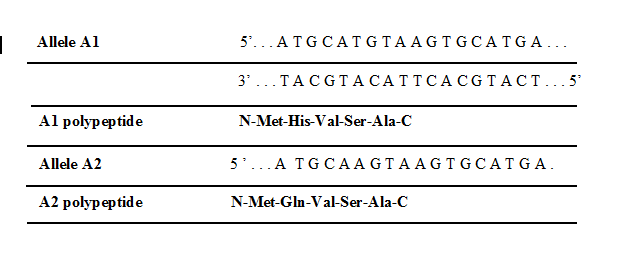
Concept explainers
To review:
In the given table, there are two DNA and polypeptide sequences shown with alleles for a hypothetical locus that generates different polypeptides of five amino acids. In both cases, the lower DNA strand is the template strand:

Based on this data of DNA and polypeptide sequence, is it possible to determine the dominant and recessive allele. Explain with reason.
Introduction:
Genotype is the organism’s genetic makeup while
The dominance or recessive terms state to the inheritance design of certain trait. The dominant alleles will produce dominant phenotype while recessive alleles produce recessive phenotype.
The resultant protein decides whether the trait is dominant or recessive.
Want to see the full answer?
Check out a sample textbook solution
Chapter 11 Solutions
Genetic Analysis: An Integrated Approach (3rd Edition)
- The results of a paternity test are shown in the table below. Numbers indicate the number of short tandem repeats for loci tested. Whos the daddy? How sure are you?arrow_forwardIn the human gene for the beta chain of haemoglobin (the oxygen-carrying protein in the red blood cells), the first 30 nucleotides in the amino-acid-coding region is represented by the sequence: 3'-TACCACGTGGACTGAGGACTCCTCTTCAGA-5'. What is the sequence of the partner strand? 4B. If the DNA duplex for the beta chain of haemoglobin above were transcribed from left to right, deduce the base sequence of the RNA in this coding region. 4C. In NOT more than 200 words, explain how eukaryotic RNA synthesized by RNA polymerase II is modified before leaving the nucleus?arrow_forwardSuppose that a bacterial DNA molecule is given a left-handed twist.How does this affect the structure and function of the DNA?arrow_forward
- . Use the following sequence data to assign haplotypes and build a haplotype network for a 200 bp variable region that is sequenced from eight individuals. Polymorphic nucleotide positions are shown. Δ is a 1 bp deletion. Explain the logic supporting the network. If there are different nucleotide changes at one position, indicate the different changes on your network. Individual 24 56 92 119 146 172 haplotype 1 A C A T G G A 2 T C Δ C G G 3 A G A T A T 4 A G A T G T 5 A C Δ C G G 6 A G A T G G 7 A G A T A T 8 C C Δ C G Garrow_forwardTwo circular DNA molecules, which we can call molecule A andmolecule B, are topoisomers of each other. When viewed under theelectron microscope, molecule A appears more compact than molecule B. The level of gene transcription is much lower for molecule A. Which of the following three possibilities could accountfor these observations?First possibility: Molecule A has three positive supercoils, andmolecule B has three negative supercoils.Second possibility: Molecule A has four positive supercoils, andmolecule B has one negative supercoil.Third possibility: Molecule A has zero supercoils, and molecule Bhas three negative supercoils.arrow_forwardIn some organisms, UV-induced thymine dimers can be repaired by photoreactivation, in which energy from visible light is used to split the bonds forming the cyclobutane ring ? true or false Non-homologous end joining occurs when enzymes cut out a few nucleotides around a double strand DNA break, and then fuse the ends back together (right) true or false?arrow_forward
- If the bandicoot genome is 3.62 x 109 base pairs, and the "highly repetitive DNA" fraction is composed entirely of copies of sequence 5'TGCGTGTGTGC3' and its complement, how many copies of this sequence are present in the bandicoot genome?arrow_forwardLet’s suppose a bacterialDNA molecule is given a left-handed twist. How does this affect thestructure and function of the DNA?arrow_forwardWhat would be a primer sequence synthesized from the following DNA sequence: 5'-ACGTG-3'? out of 5'-GTGCA-3', 5'-CACGT-3', 5'-CACGU-3', 5'-TGCAC-3', or 5'-ACGTG-3'?arrow_forward
- Using a laser beam, you isolated several R bands from human chromosomes. Answer the following questions What kinds of genes are present in R bands? Which isochors do you expect to be present in the R band? What class of interspersed repeats will be present in R bands? What class of tandem repeats do you expect to find in RG bands? Would you expect to find telomere sequences in some R bands?arrow_forwardIn genetic transformation, what is meant by the wordcompetence?arrow_forwardWhy is DNA supercoiling called supercoiling rather than just coiling? Why is positive supercoiling called overwinding and negativesupercoiling called underwinding? How would you define theterms positive and negative supercoiling for Z DNA?arrow_forward
